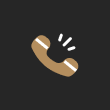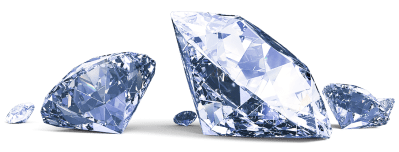
5 Expert Tips for Spotting Fake Diamonds
If you are not a diamond person or do not know enough about diamonds, it might get difficult for you to differentiate between a real and a fake diamond. A girl's world could crumble around her if the stone turns out to be a fake, and you don't know how to tell if a diamond is real. The knowledge needed to detect a fake diamond seems like something only a professional gemologist or jeweller would or should need to know. Diamond purchases stand out from all other purchases you will ever make. You are buying a rare commodity that is in high demand and can go for very steep prices. To prevent such a horrible scenario, you need to take precautions and become educated in regard to markers pointing at a true diamond. So we decided to list a few possible guidelines. Here is how to spot fake diamonds:
1.How to spot fake diamonds with fog test

A quick and easy way to tell if your diamond is real or fake is by doing a fog test. The fog test is an easy method to determine whether a diamond is genuine or not. One can observe the stone fog up quickly by exhaling on it. You might be able to tell whether a stone is real or fake just by breathing on it because a fake one won't be able to absorb heat. To fog the diamond, position it in front of your mouth as you would your glasses before cleaning them. If the fog or moisture stays on the surface of the diamond for a long time, it’s probably fake. Real diamonds disperse heat very quickly, almost instantaneously, so they do not stay foggy for too long. Make sure your diamond is clean and free of oil before performing this test. Additionally, diamond jewellery cannot be used for this test; only loose diamonds can be used.
2.How to test fake diamonds with water

The water test is a quick and simple way to check a diamond's authenticity. This is the easiest way to find out if your diamond is real. To use this test, Get a glass full of water at room temperature, and carefully drop the loose diamond into the glass. The gemstone is a real diamond if it sinks. If it floats underneath or at the water's surface, you have a fake on your hands. Diamonds sink in water because they are heavy and made of dense elements. Fake diamonds, on the other hand, are typically created using lighter substances like quartz or cubic zirconia and will therefore float. You might want to use a different strategy here because not all fake diamonds float in water. Additionally, when submerged in cold water, the diamond ought to capture air bubbles. Any floating object without the strong surface tension that draws air bubbles into diamonds is probably a fake. This test determines the density of your diamond.
3.Spotting fake diamonds with sparkle test

The sparkle test is one of the most common methods for determining whether a diamond is real or fake. A fake diamond might appear dull or a little blurry, while a real diamond will reflect light uniquely and brilliantly from every angle. Quartz and glass, which can't imitate the sparkle of a real diamond, are frequently used to make fake diamonds. The only equipment needed for the sparkle test is your eyes. Hold the diamond up to the light and move it around at various angles while observing the sparkles and brightness it emits to perform the sparkle test. A real diamond provides exceptional sparkle since it reflects white light extremely well. If it doesn’t have a unique sparkle and appears dull, it’s probably a fake diamond. It's important to keep in mind that none of these imitation diamond materials compare to real diamonds in terms of strength, clarity, or durability. Compared to stone-like cubic zirconia, you'll be able to see a huge difference in the white and colored light sparkle. A cubic zirconia gives off a noticeable rainbow of light. However, it is advised that you don't use this as your only testing method, so try and use the other methods highlighted here.
4.Thermal test/Diamond tester tool

Also known as the thermal conductivity probe or the diamond tester tool. This diamond lighter test is used to determine the thermal conductivity of a gemstone. It measures the rate at which a diamond disperses heat. True diamonds are excellent heat conductors, allowing heat to be dissipated quickly and uniformly throughout the gemstone. Conversely, false diamonds cannot disperse heat as effectively, thus revealing noticeable hotspots when the heat source is removed. Real diamonds will disperse heat quickly after being warmed, whereas fake diamonds release heat at a slower rate. If the diamond is real, it should quickly return to its initial temperature without any unevenness after being gently touched with a heated needle or lighter for several seconds. If hotspots are discernible, the diamond is most likely phony. It's important to note that this test is inconclusive with moissanite because synthetic moissanite stones frequently have heat dispersion that is comparable to or equal to that of genuine diamonds.There are many different diamond testers out there, so pick the one you like the most.
5.UV fluorescence test on fake diamonds

The UV fluorescence test is an intriguing way to tell real diamonds from fakes when determining whether a diamond is real in another way. Genuine diamonds emit an electric blue hue when exposed to UV light, while fake ones do not. But not all diamonds emit blue light when exposed to UV; some emit other colours instead, such as yellow, orange, red, or green, which can help you distinguish them from other gemstones. It's interesting to note that natural diamonds glow blue more frequently than synthetic ones, making this technique useful for differentiating between the two. Before making assumptions about a diamond's authenticity, one should keep in mind that some diamond treatments can have an impact on their fluorescence, so it is advisable to consult an expert. Overall, the UV fluorescence test is a simple and quick procedure that doesn't call for any specialised tools or knowledge. It is best to have a diamond specialist or jeweller use their sophisticated equipment to test the stone because this test is not conclusive.
When looking for diamonds, especially GIA Certified Diamonds, it’s crucial to be aware of the possibility of purchasing counterfeit items. You can prevent being duped by carefully inspecting a diamond using various tests, such as weighing it on scales or looking for flaws under a loupe. However, the best way to ensure that you are buying a genuine diamond is to purchase one that comes with a GIA certification. GIA Certified Diamonds have been thoroughly evaluated by the Gemological Institute of America (GIA), a respected authority in the diamond industry, and their quality has been verified. When you buy a GIA Certified Diamond, you can be confident that you are getting a genuine and high-quality diamond.
A good jeweller is a key to not getting cheated when buying diamonds. With V. Jayantilal & Co., finding the right jeweller is a breeze. Our authentic algorithm connects enthusiastic buyers with reliable jewellers. Diamond shopping just became super simple. Your perfect diamond is only a click away.







